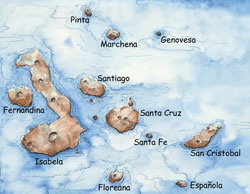|
Hot Topics: Introduction to the Galápagos Islands by Dennis GeistThe Galápagos is a group of volcanic islands (sometimes called an archipelago); each of the 13 major islands is made up of at least one volcano. Isabela island, in the west, is the biggest island (over 75 miles long) and made up of six overlapping volcanoes: Cerro Azul, Sierra Negra, Ecuador, Alcedo, Darwin, and Wolf. The first three mean Blue Hill, Black Mountain, and Equator in Spanish. Alcedo is named after an Ecuadorian government official, and Darwin and Wolf after two of the most famous scientists to have visited the archipelago. Otherwise, the volcanoes and the islands share the same name, so when we say “Floreana” we mean both Floreana Island and Floreana Volcano.  Watercolor painted map of the Galapagos Islands by E. Paul Oberlander, WHOI, with the major islands labeled. The western Galápagos are made up of Isabela and Fernandina. These are the youngest islands in the archipelago and the region where we will be spending most of our time on this expedition. Although these islands make up the greatest surface area in the Galápagos, only about a thousand people live in the western Galápagos, on the southeastern tip of Isabela. Fernandina is one of the largest wilderness islands on Earth. Most volcanic eruptions in the archipelago are from the western volcanoes, the most recent in 1998 at Cerro Azul, and in 1995 at Fernandina. The western Galápagos volcanoes have a unique shape for a shield volcano, with especially steep flanks, and volcanologists have defined a category called “Galápagos-type shields.” Because they are so young, with lavas that are all less than a few hundred thousand years old, geologists believe that these volcanoes mark the leading edge of the Galápagos hotspot. The northern Galápagos is made up of Wolf, Darwin, Pinta, Marchena, and Genovesa islands (the names are confusing: Wolf and Darwin are volcanic islands in the north but also the names of volcanoes on Isabela). The ages of these islands are not well known, although in 1991 Marchena erupted. No one knows why these islands formed here, but it probably has something to do with the hotspot “leaking” northwards, towards the Galapagos Spreading Center, part of the Mid-Ocean Ridge. The central Galápagos comprises three main islands, San Cristobal, Santa Cruz and Floreana and is where most of the population of the Galápagos lives. The Darwin Research Station is located on Santa Cruz island, which is where the main town of Puerto Ayora is located. Although there are some younger lavas on these islands, on the whole they are much older -- ranging from about 1 to 3 million years old -- than the islands to the west.
|
|
© 2010 Dive and Discover™. Dive and Discover™ is a registered trademark of Woods Hole Oceanographic Institution
|
|

